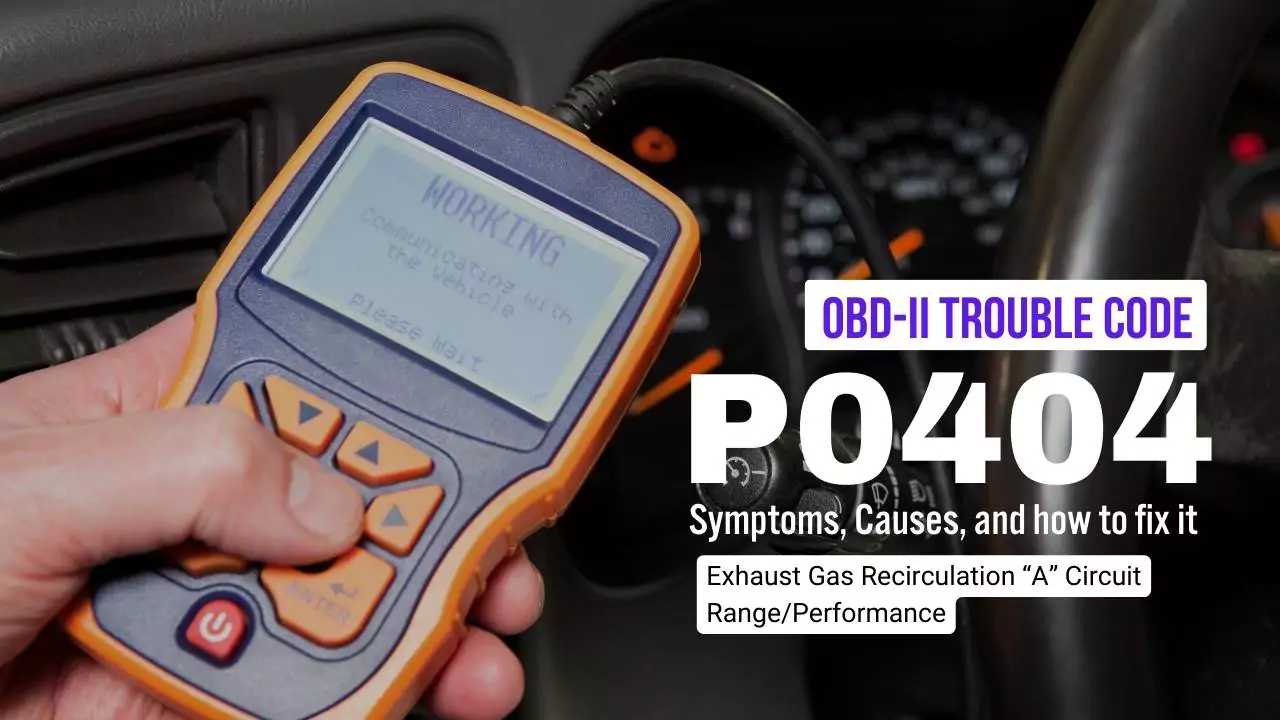You’ve just seen the Check Engine Light come on, and you are stumped as to what could be causing the problem. Your OBD-II scanner might reveal the P0404 code, but what does this mean?
In this comprehensive guide, I cover the causes and meaning behind the P0404 DTC. I also show you the top symptoms you can expect and give you some suggestions about how to fix it. By the end of this article, you might even gain a better understanding of the EGR system.
What Does the P0404 Code Mean?
P0404 – Exhaust Gas Recirculation “A” Circuit Range/Performance.

The P0404 diagnostic trouble code means that the Exhaust Gas Recirculation Circuit Range/Performance fault has occurred. This generic trouble code comes from the powertrain control module (PCM) and indicates that the Exhaust Gas Recirculation (EGR) valve is not functioning correctly.
Normally, this code indicates that the parameters aren’t in line with where they should be with the EGR valve. For example, if the valve should be fully open but it only opens partially, this code will be set.
P0404 Trouble Code Symptoms
In most cases, the P0404 trouble code is only going to cause the Check Engine Light to come on. Otherwise, you might not notice any performance issues at all. In some rare cases, there could be other symptoms.
Here are the most common P0404 symptoms.
- Check Engine Light
- Erratic idling
- Reduced fuel economy
- Increased emissions
Causes of the P0404 Code
The only way to figure out what’s causing the P0404 trouble code is to walk through the complete diagnostic steps listed below. After your examination, you might find that one of these causes is to blame.
- Defective EGR valve/sensor
- Clogged EGR valve or pipes
- Electrical short in circuit or ground
- Malfunctioning PCM
- Intake leak
- Faulty MAF/MAP sensor
How Serious is the P0404 Code?
Medium – Because the Check Engine Light might be the only problem you notice, you might think it’s safe to drive wherever you want and procrastinate on a fix. However, this is a bad idea.
You want to have this issue dealt with sooner than later. Continuing to drive with this fault could lead to larger engine issues that would increase the repair cost later.
What Repairs Can Fix the P0404 Code?
You don’t need to wonder what’s going to fix the P0404 DTC. Instead, perform a complete diagnostic evaluation to discover the issue. Once you know what’s causing the problem, you can get it fixed.
Here are some of the most common fixes to the P0404 trouble code.
- Repair electrical short in circuit or ground
- Clean EGR Valve or pipes
- Replace EGR valve/sensor
- Update/replace PCM
- Repair intake leak
- Replace MAF/MAP sensor
Common P0404 Diagnosis Mistakes
The last thing you want to do is replace the EGR valve or sensor without first inspecting the entire system. You might spend money to replace a part when it’s not needed.
Instead, your issues could stem from a faulty connection or frayed wiring. Instead of replacing a part, you could just fix the wiring problem.
How to Diagnose the P0404 Trouble Code
If you’ve never worked with the EGR system, you might not know how to diagnose a problem. I have listed out the same steps that a professional mechanic would use, making it easier for you to figure out what’s wrong.
Here are some steps to follow, as long as they fall in line with your car’s service manual.
- Read all of the trouble codes. Use freeze frame data to pinpoint what’s going on.
- Check all of the connections. Look for frayed wiring or a loose connection.
- Inspect the EGR valve for a buildup of carbon. You can clean off the carbon and see if that fixes the problem.
- Check the values from the MAF sensor or MAP sensor. Clean the sensor if it is dirty, and replace it if necessary.
- Check for any intake leaks or leaks from the EGR pipes.
- Replace the EGR valve/sensor based on what you determine is wrong.
If these steps don’t help you figure out what’s going on, it’s best to visit a professional mechanic. Your local auto repair shop has the equipment needed to further diagnose the issue. They can also reprogram or replace the PCM without a lot of trouble.
Estimated P0404 Repair Cost
The cost to fix this error code will vary widely depending on what you determine the root cause to be. Everything I estimate below includes approximate labor and parts charges. If you can perform the repair on your own, you might not spend as much money.
- Repair electrical short in circuit or ground – $50-$500
- Replace EGR valve/sensor – $250-$650
- Update/replace PCM – $250-$2,500
- Replace MAF/MAP sensor – $200 – $500
Mechanics Tips about the P0404 Code
Before you can fully repair the P0404 DTC, you must first understand the EGR system. Your car’s EGR system is responsible for redirecting exhaust gas through the engine so the cylinder temperatures can be reduced. This process also reduces nitrogen oxide emissions for a cleaner environment.
In the EGR system, there’s a valve needed to regulate the amount of flow of exhaust that’s moving back into the motor. This valve is controlled by the PCM. Information is also sent back from the sensor to the PCM showing its position – whether it is closed, open, or in-between.
By understanding the EGR system, you will have a better idea of what you are reading in the service manual. With this knowledge, you should be able to repair the issue on your own after a complete diagnostic evaluation.
You can also read more advanced specs about the EGR system if you are looking to go deeper. Otherwise, you are going to have to visit a professional shop to get more help.